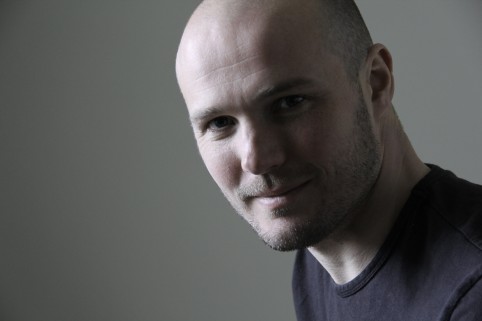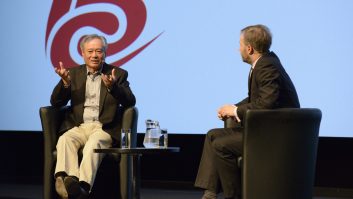
By Richard Welsh, SMPTE governor for EMEA and Central & South America Region and CEO at Sundog Media Toolkit
Since its inception, cinema has always had one particular facet that is very difficult to reproduce anywhere else: size. That enormous screen fills your vision and draws you into the picture.
Earlier this year, Qantas Airlines teamed up with Samsung to bring virtual reality (VR) headsets on to flights and into airport lounges. This technology could be used, in theory, to reproduce a cinema screen of virtually any size. Or, the experience could be taken much further and place the viewer right into the movie. Of course, we’re not quite there just yet. A lack of content is easy to point to, and it’s also fair to say there is still a big question over consumer acceptance of VR.
Whether VR is posing a real commercial threat to cinema is doubtful (for now), but cinema doesn’t have a long history of standing still and always seems to react to advances in consumer media technology with its own push to improve the experience. While VR companies speak of the immersive experience, it’s the cinema that has always held this high ground and now is looking to take it further.
Range of IBC sessions
Acknowledging this fact, the IBC conference is once again looking at the latest developments in cinema technology. On Monday in the Big Screen conference stream, there will be a big focus on immersive cinema, with a session on immersive picture being produced by Pete Ludé, SMPTE past president and senior vice president at RealD.
In the future, immersive cinema may well incorporate VR or augmented reality (AR) technologies. Right now, though, the push is to capitalise on the big screen by extending it to the peripherals of our vision. 20th Century Fox has already produced immersive movies shown in Barco’s proprietary Escape format that extends the visual experience to two extra screens at the side of the main screen and uses a three projector setup.
Wraparound cinema is not new, of course; there have been various ‘ultra-wide’ formats over the years, stretching back to the Cinerama format of the early 1950s that used three projectors and a deeply curved screen. Another advance in technology that accompanied Cinerama was the innovative use of surround sound to enhance the experience.
History repeats itself here too, with object-based and immersive audio formats for the cinema already gaining significant traction. IBC2015 is looking at developments here alongside the immersive picture investigation.
Of course, there’s more to improving the experience than just making it bigger. Other innovations in this area include higher frame rate (HFR), a wider colour gamut (WCG), and higher dynamic range (HDR). The IBC2015 Big Screen conference stream dedicates a three-part session to HDR across Friday and Saturday, produced by Robert Kisor, SMPTE past president and Fellow. HDR raises an interesting question about the proliferation of these experiential improvements.
From a human perception point of view, they all interact. Sound has a clear influence on our perception of picture, and frame rate has an influence on our perception of 3D. Contrast (afforded by dynamic range) has an influence on our perception of resolution. And so it goes on. Of course, the beauty of digital technology is that the barriers to improving all these elements are falling away.
The challenge is that if these technology improvements interact and influence each other, then it would make sense to improve all of them at once to get maximum impact. You’re probably several steps ahead of me here in thinking, “It’s just not that simple, is it?”
It’s worth remembering that digital technology is a relatively recent development in cinema exhibition, with the transition to digital screens only just completed. Cinema feels to me right now a little like a kid in a sweet shop. (I’m as guilty of that excitement as anyone.) In actual practice, the exploration of these formats all at once is bringing its own challenges.
Digital Cinema Update
From my perspective at Sundog Media Toolkit, the impact is evident in a couple of ways. First, there are challenges with the source material. For example, we recently ran noise management tests on HFR, HDR, high-res footage. The issue for capture is that with HFR, the camera sensor needs to operate at a higher ISO to retain dynamic range.
This change in sensitivity and exposure range affects the impact of noise on the captured image, and the upshot is that noise becomes an issue for the rest of production and post production through grading, visual effects (VFX), distribution, compression and — ultimately, if not addressed — the final image quality seen by the audience. We are observing significant increases in demand for tools that deal with this particular issue, and this interest reflects the fact that noise management is becoming an essential part of the pipeline for those working in high resolution, HFR, HDR, WCG, etc.
At the other end of the spectrum, we see format proliferation — an attempt to cope with the fact that not all cinemas are capable of handling all formats. Cinema still faces the massive challenge of transitioning fully to the SMPTE Digital Cinema Package (SMPTE-DCP) format, and until that challenge is met, a dual inventory of legacy Interop DCP as well as SMPTE DCP is needed for distribution.
Add to this the challenge of handling various flavours of immersive audio on top of 5.1 and 7.1 surround, and the usual language versions (both subtitled and dubbed) with HFR, 2D versus 3D, and more. The result: ballooning volumes of versions required for a big movie release to cater to all the possible playback configurations a cinema may support.
A couple of years ago, seeing that this was a challenge likely to increase over time, we made the decision to move to cloud to deal with the scaling issue. I’ll discuss in more detail what these new challenges for cinema look like and how we deal with them practically in the popular European Digital Cinema Forum’s ‘Digital Cinema Update’ on Sunday in the Big Screen stream.
We will continue the conversation and advance it further into the future at the SMPTE 2015 Annual Technical Conference & Exposition (SMPTE 2015) from 27-29 October in Hollywood. The signature SMPTE event will be preceded on Monday, 26 October by the day-long SMPTE 2015 Symposium, which will be dedicated to looking at VR and AR technologies.
The impact of VR and AR on cinema, moviemaking, and media in general will be explored in this not-to-be missed conference. The virtualisation doesn’t stop there, though.
The technical conference, which extends from Tuesday to Thursday, will take a more in-depth look at virtual production and post pipelines in the cloud, as well as challenges and innovations in image processing and the continued rise of IP technologies in the media facility. Find out more at www.smpte2015.org






